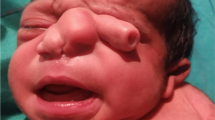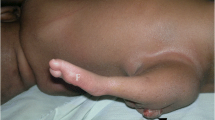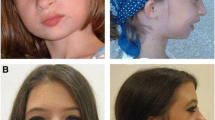Abstract
A case report is given on a newborn infant with peromelia and malformations in the area of the first visceral arch. Upper and lower jaw were partially grown together and hypoplasia of the mandible as well as microstomia, obliteration of the lower vestibulum, hypoplasia of the tongue, a cleft palate, and a soft tissue bridge between the rudimentary tongue and the palate were observed. Similar syndromes are described in the literature as Hanhart's syndrome II, Ankyloglossum superius with peromelia (Cosack), and - in cattle — Akroteriasis congenita. These syndromes are discussed. In our patient dermatoglyphics on the tips of the defect limbs were evidence of a disturbed development in early embryonic life. The etiology is obscure.
Zusammenfassung
Es wird über ein Neugeborenes berichtet, das einen Mißbildungskomplex aus zwei Komponenten aufwies: 1. asymmetrische Peromelie, 2. Mißbildungen im Bereich des ersten Kiemenbogens. Vergleichbare Mißbidungs-syndrome wurden für den Menschen beschrieben als Hanhart-Syndrom II und Ankyloglossum superius mit Peromelie (Cosack). Bei Rindern ist ein ähnliches — erblich bedingtes — Syndrom bekannt als Akroteriasis congenita. Die Beziehung zu diesen Syndromen wird diskutiert. Bei unserem Patienten deuteten Papillarleistenmuster an den Extremitätenstümpfen auf eine frühembryonale Entwicklungsstörung. Die Ätiologie ist unklar.
Similar content being viewed by others
Literatur
Cosack, J.: Die angeborene Zungen-Munddach-Verwachsung als Leitmotiv eines Komplexes von multiplen Abartungen. (Zur Genese des Ankyloglossum superius.) Z. Kinderheilk. 72, 240 (1952/53).
Garner, L. D., Bixler, D. B.: Micrognathia, an associated defect of Hanhart's Syndrome, Types II and III. Oral Surg. 27, 601 (1969).
Greene, H. S. N., Saxton, J. A.: Hereditary brachydactylia and allied abnormalities in the rabbit. J. exp. Med. 69, 301 (1939).
Hanhart, E.: Über die Kombination von Peromelie mit Mikrognathie, ein neues Syndrom beim Menschen, entsprechend der Akroteriasis congenita von Wriedt und Mohr beim Rind. Arch. Klaus-Stift. Vererb.-Forsch. 25, 531 (1950).
Hepp, O.: Die Häufigkeit der Angeborenen Defektmißbildungen der oberen Extremitäten in der Bundesrepublik Deutschland. Med. Klin. 57, 419 (1962).
Hövels, O.: Zur Pathogenese der Mißbildungen des ersten Visceralbogens. Z. Kinderheilk. 73, 568 (1953).
—: Mißbildungen des Kopfes und Störungen früher Phasen der Kephalogenese. In: H. Opitz u. F. Schmid, Hdb. der Kinderheilkunde, Bd. VI, S. 225. Berlin-Heidelberg-New York: Springer 1967.
Koehler, O.: Die hand- und fußlosen brasilianischen Geschwister. Z. menschl. Vererb.- u. Konstit.-Lehre 19, 670 (1936).
Kohler, H. G.: Congenital transverse defects of limbs and digits. Arch. Dis. Childh. 37, 263 (1962).
Lenz, W., Knapp, K.: Die Thalidomid-Embryopathie. Dtsch. med. Wschr. 87, 1232 (1962).
Mackler, B.: Studies of the molecular basis of congenital malformations. Pediatrics 43, 915 (1969).
Martius, G., Walter, S.: Peromelie und Mikrognathie als Mißbildungskombination (Hanhartsches Syndrom). Z. Geburtsh. und Frauenheilk. 14, 558 (1954).
Milew, L.: Intrauterine Amputation des Fußes durch amniotische Stränge. Zbl. Gynäk. 60, 127 (1936).
Pließ, G.: Pränatale Schäden. Ergebn. inn. Med. Kinderheilk. 17, 264 (1962).
—: Beitrag zur teratologischen Analyse des neuen Wiedemann-Dysmelie-Syndroms. Med. Klin. 57, 1567 (1962).
Seidel, F.: Entwicklungsphysiologie der Tiere. Berlin: Walter de Gruyter & Co. 1953.
Starck, D.: Embryologie. Stuttgart: Thieme 1955.
Warkany, J., Nelson, R. C.: Appearance of skeletal abnormalities in the offspring of rats reared on a deficient diet. Science 92, 383 (1940).
Weicker, H., Bachmann, K. D., Pfeiffer, R. A., Gleiß, J.: Thalidomid-Embryopathie. Dtsch. med. Wschr. 87, 1597 (1962).
Werthemann, A.: Die Entwicklungsstörungen der Extremitäten. In Lubarsch-Henke-Rössle: Hdb. der spez. pathol. Anatomie, Bd. IX, 6. Berlin-Göttingen-Heidelberg: Springer 1952.
Wriedt, Chr., Mohr, O. L.: Amputated a recessive lethal in cattle; with a discussion on the bearing of lethal factors on the principles of live stock breeding. J. Genet. 20, 187 (1928/29).
Author information
Authors and Affiliations
Additional information
Herrn Prof. Dr. W. Künzer zum 50. Geburtstag
Rights and permissions
About this article
Cite this article
Wehinger, H. Kiefermißbildung und Peromelie. Z. Kinder-Heilk. 108, 46–53 (1970). https://doi.org/10.1007/BF00440565
Received:
Issue Date:
DOI: https://doi.org/10.1007/BF00440565




